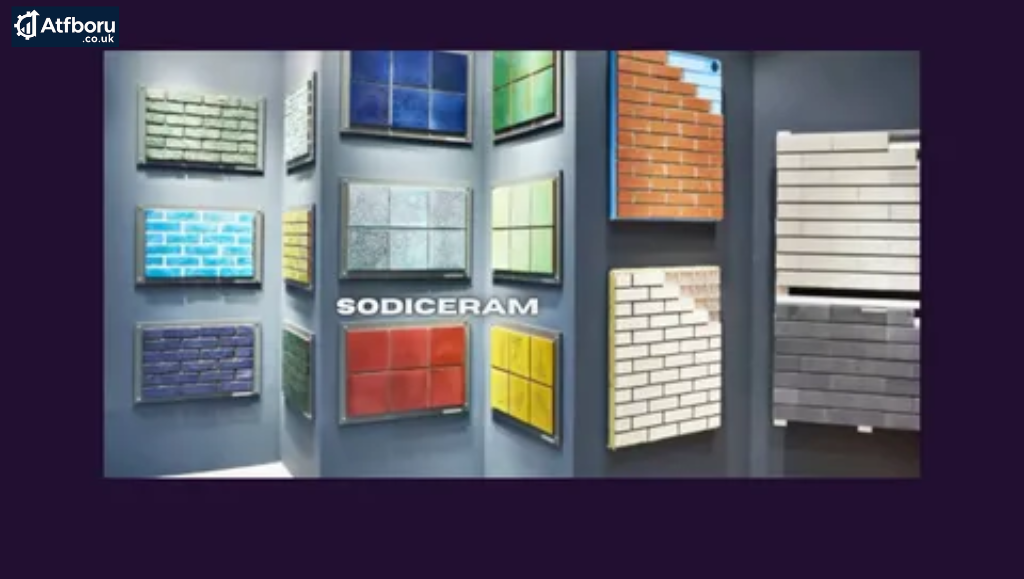In the world of advanced materials, the demand for high-performance ceramics has led to the development of innovative solutions. One such solution is Sodiceram, a next-generation sodium-infused ceramic that is reshaping the way architects, designers, and engineers approach durability, design versatility, and performance.
Unlike traditional ceramics, Sodiceram integrates sodium-based compounds like sodium feldspar and sodium carbonate (Na₂CO₃) into the ceramic matrix to offer superior characteristics such as low porosity, higher flexural strength, and improved thermal shock resistance. This article explores the emergence of Sodiceram, its unique material properties, applications, and its position within the broader ceramic market.
What is Sodiceram and How Did the Concept Emerge?
Sodiceram is a cutting-edge ceramic manufacturing material infused with sodium-based compounds, particularly sodium feldspar. This infusion enhances the material’s vitrification process, reduces porosity, and improves both mechanical strength and thermal resistance. Unlike conventional ceramic or porcelain materials that rely on kaolin clay and feldspar for vitrification, Sodiceram achieves superior performance through sodium’s unique role as a flux agent.
The concept of Sodiceram emerged from a convergence of advanced ceramic engineering and the growing demand for more durable and versatile materials in architectural and industrial applications. Researchers recognized the potential of sodium to facilitate controlled vitrification at lower temperatures, which led to the development of Sodiceram. Over time, breakthroughs in sodium-based compound integration paved the way for its commercialization in applications ranging from flooring to ceramic cladding, countertops, and beyond.
What Unique Material Science Principles Underpin Sodiceram?
At the core of Sodiceram‘s innovation is its reliance on sodium-based compounds to enhance the ceramic matrix. Sodium acts as a flux, lowering the melting temperature of silica and alumina, and improving the densification process during firing. This enables Sodiceram to achieve superior glass-phase formation, which reduces porosity and enhances structural cohesion.
Key material science principles behind Sodiceram include:
- Fluxing Agents: Sodium facilitates liquid-phase sintering, reducing energy consumption and promoting tighter grain packing at lower firing temperatures.
- Glass-Ceramic Formation: Sodium promotes the formation of a glassy phase that envelops crystalline grains, resulting in a denser, more durable product.
- Thermal Expansion Control: The careful balance of sodium content helps in controlling thermal expansion, ensuring that Sodiceram performs well under varying temperature conditions.
What Are the Key Performance Advantages of Sodiceram?
Sodiceram offers a range of performance advantages that make it superior to traditional ceramics:
- Low Porosity: Sodiceram achieves porosity levels as low as 0.5%, significantly improving stain resistance, water resistance, freeze-thaw durability, and chemical exposure resistance.
- High Strength: With a flexural strength surpassing 40 MPa, Sodiceram exceeds the typical range for porcelain and other conventional ceramics, making it ideal for high-traffic environments.
- Thermal Shock Resistance: Sodiceram can withstand sudden temperature changes of up to 200°C without cracking, making it suitable for applications such as kitchens and laboratories.
- Chemical Resistance: Unlike standard ceramics, Sodiceram resists acids, alkalis, and household chemicals without degradation, making it an excellent choice for industrial ceramics and corrosive environments.
In Which Applications Does Sodiceram Shine?
Sodiceram‘s unique properties make it suitable for a variety of applications:
- Residential Spaces: From kitchen countertops to bathroom cladding, Sodiceram‘s aesthetic versatility and durability make it an ideal choice for homes. Its resistance to staining and scratching is especially beneficial in high-use areas like kitchens.
- Commercial Settings: Airports, hospitals, and shopping centers benefit from Sodiceram’s ability to withstand high foot traffic, chemicals, and thermal shock resistance. It is also used in industrial facilities such as laboratories and cleanrooms.
- Architectural Façades: Sodiceram‘s UV stability and low maintenance make it perfect for high-rise cladding and ventilated façades, offering both durability and aesthetic appeal.
How to Specify, Design, and Install Sodiceram Surfaces?
When specifying Sodiceram, architects and designers should consider factors such as finish, color, thickness, and mechanical strength. The installation process is crucial to ensure Sodiceram performs at its best:
- Preparation: Ensure substrates are flat and stable with sufficient compressive strength.
- Adhesives: Use flexible cementitious adhesives (C2TES1) to accommodate the material’s thermal expansion.
- Quality Checks: Key checks include tile flatness, edge straightness, and adhesive coverage (at least 90% for large-format tiles).
What Does the Cost Structure and Market Look Like for Sodiceram?
The cost of Sodiceram typically ranges from $35 to $70 per square meter, depending on finish and thickness. While it is more expensive than traditional ceramic tiles, Sodiceram offers superior durability and a longer lifespan, making it a cost-effective choice over time. Manufacturers also offer Sodiceram at a 20–30% premium over porcelain, positioning it as a premium material in the market.
What Sustainability and Lifecycle Aspects Should Be Considered?
Sodiceram aligns well with sustainability goals due to its energy efficiency in manufacturing. Sodium fluxing reduces firing temperatures, saving energy and lowering the overall environmental impact. Additionally:
- Recyclability: At the end of its life, Sodiceram can be crushed and reused as aggregate for concrete or road construction.
- Embodied Carbon: The embodied carbon of Sodiceram is significantly lower than that of porcelain, making it a more environmentally friendly option.
What Are the Main Competitors or Alternative Technologies to Sodiceram?
Sodiceram competes with materials like porcelain, sintered stone, and advanced ceramics. While Sodiceram offers a more affordable alternative to sintered stone, it provides comparable durability and resistance to environmental stresses at a lower price point. Additionally, emerging materials like nanoceramics and smart ceramics integrate sensors or self-healing properties, but they come at a higher cost. Sodiceram strikes a balance between affordability and performance, making it a popular choice for many applications.
What Future Innovations and Research Directions Exist for Sodiceram?
The future of Sodiceram looks promising, with research focusing on:
- Smart Surfaces: The integration of sensors and IoT technologies into Sodiceram surfaces could pave the way for applications in smart buildings, such as self-diagnosing façades and temperature-regulating floors.
- Additive Manufacturing (3D Printing): Advances in 3D printing could allow for more intricate designs and customized Sodiceram components, especially in architectural and medical applications.
- Lighter, Thinner Versions: Ongoing research aims to create ultra-thin Sodiceram panels that maintain strength while offering reduced weight for use in modern, lightweight building designs.
What Are the Benefits of Using Sodium-Based Compounds in Ceramics?
The incorporation of sodium-based compounds, such as sodium feldspar and sodium carbonate (Na₂CO₃), provides several benefits:
- Improved Vitrification: Sodium promotes the glass-phase formation, enhancing densification and reducing residual porosity.
- Lower Firing Temperatures: Sodium fluxes lower the firing temperature, reducing energy consumption and enabling more sustainable manufacturing practices.
- Enhanced Durability: Sodium strengthens the ceramic matrix, increasing resistance to wear resistance, thermal shock, and chemical exposure.
Applications of Sodiceram in Various Industries
Sodiceram is versatile enough to be used across several industries:
- Residential and Commercial Construction: Ideal for flooring, countertops, and cladding.
- Industrial Applications: Useful in cleanrooms, laboratories, and food processing plants.
- Artistic and Decorative Uses: Suitable for sculptural applications, digital printing, and customized designs in both commercial and residential settings.
Advantages and Limitations of Sodiceram
Advantages:
- Durability: Superior resistance to mechanical wear, thermal shock, and chemical exposure.
- Aesthetic Flexibility: Available in various surface finishes, including matte, glossy, and custom designs.
- Sustainability: Lower carbon footprint and energy consumption during manufacturing.
Limitations:
- Brittleness: Like all ceramics, Sodiceram can be brittle under high-impact loads or when improperly installed.
- Cost: While more affordable than sintered stone, it is still pricier than conventional ceramics.
Sodiceram vs. Traditional Ceramics: A Detailed Comparison
Sodiceram outperforms traditional ceramics in several areas:
- Porosity: Traditional ceramics typically have higher porosity, which can lead to water absorption and reduced durability. Sodiceram has ultra-low porosity, improving its resistance to moisture, stains, and freezing.
- Strength: With a flexural strength exceeding 40 MPa, Sodiceram is stronger than many traditional ceramics, making it ideal for high-traffic areas.
- Chemical and Thermal Resistance: Sodiceram excels in environments exposed to high temperatures or chemicals, which traditional ceramics may not withstand.
Conclusion: Why Sodiceram Is the Future of Ceramics
Sodiceram represents a significant leap forward in ceramic technology. Incorporating sodium-based compounds, it offers a combination of durability, versatility, and sustainability that is unmatched by traditional ceramics. Whether used in residential, commercial, or industrial applications, Sodiceram is positioned to redefine the future of ceramics, offering superior performance and design freedom that meet the evolving demands of modern architecture and design. With its ongoing innovation, Sodiceram will continue to lead the charge in sustainable, high-performance building materials.
CHAS6D: The Future of Cybernetic Systems

